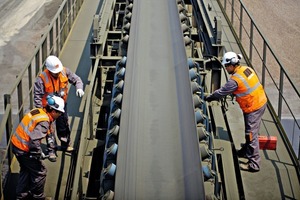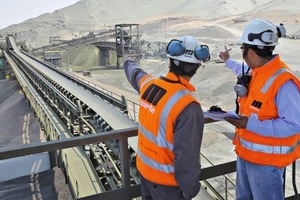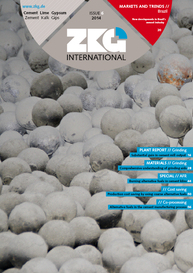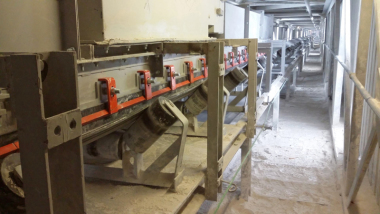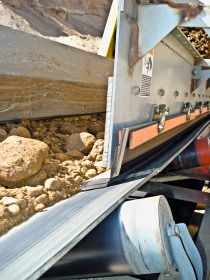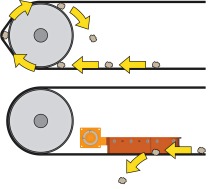Conveyor inspection program reduces costs and improves safety
A global leader in bulk material handling technology is helping conveyor users reduce operating costs and improve safety with inspection and maintenance programs designed specifically for each individual system. The Walk the BeltTM program from Martin Engineering provides regularly-scheduled reviews of belts, cleaners, tracking, chutes, dust control and other components from experienced specialists with the training and expertise to maximize productivity and reduce downtime. Featuring immediate transfer of data and photos to facility managers, the program establishes an evolving record of each belt for current analysis and future reference. By taking responsibility for routine maintenance and identifying potential issues before components fail, technicians assist customers in maintaining system performance and extending service life, while minimizing fugitive material and unplanned shutdowns.
“Every conveyor is different, even within the same facility” observed Martin Engineering Global Market Development Manager Mark Stern. “So we create a specific inspection plan based on the design, capacity, throughput requirements and the desired level of fugitive material abatement.”
Stern said that while it’s common for conveyor owners to perform service on their systems only when a component fails, it’s actually less expensive in the long run to incorporate continuous maintenance into a plant’s operational plan. “Routine inspections can extend the life of the belt and conveyor components by preventing correctable issues from turning into major and costly headaches,” he explained. “These programs help our customers maximize the throughput and safety of their conveyors, while reducing the chances of catastrophic failure that could interrupt production.”
Conducting conveyor inspections and maintenance can pose significant risks to employees, as these activities bring workers into close proximity with the conveyor system under potentially dangerous conditions. Staff members are exposed to moving belts, rolling components and pinch points, all in an environment that is commonly dirty, distracting and noisy. Outsourcing those functions to trained professionals will relieve system managers of the burden.
As plants across many industries struggle with staff reductions, some facilities now entrust some or all of their conveyor equipment installation and maintenance work to outside contractors. The approach keeps maintenance management in the hands of the plant, while outsourcing the actual labor.
One of the advantages of the Martin® Walk the BeltTM program is that it relieves plant personnel from a duty for which they may not be well-trained, allowing them to remain focused on core business activities. “Our technicians are a specialized group, with the expertise necessary to achieve high conveyor efficiency and keep the system running at maximum productivity,” added Value Stream Manager Mark Strebel. “They’re well-versed in current best practices and regulations, able to advise customers on proven solutions for common industry issues such as safety, dust management and spillage reduction.”
Fugitive material management is a key element of the inspection program, and one of Martin Engineering’s specialties. As problems from the creation, accumulation or escape of dust are multiplied by the increased possibility of regulatory citations, fines and shutdowns, it’s imperative that plants prevent the escape of fugitive particles. A key to minimizing the release of dust is the proper maintenance of components such as belt cleaners, transfer point seals, dust curtains, suppression systems and air cleaning equipment. Proper adjustment and timely service will minimize carryback and dust issues all along the conveyor.
The Martin Engineering technicians do more than walk along the length of the belt, of course. In fact, one of their inspection techniques is standing stationary at a number of points along each conveyor and watching one or more complete revolutions of the belt, noting its condition, tracking, carryback and other observations. They take detailed notes, identifying trouble spots by component name and location as they are found, often logging data directly into a smart phone or tablet immediately at the site. Digital cameras and other devices allow the technicians to take photos, record video, make rough measurements and perform other tasks, then share a wealth of information with customer operations personnel for discussion and prioritizing.
Maintenance and repair tasks can be included in the program and performed routinely, or scheduled upon request. Martin Engineering professionals can also provide a comprehensive survey of the entire plant’s material-handling system, including measured levels of respirable and fugitive dust and spillage. This report delivers grid-based results, giving the client real information that can be used to prioritize needs and avoid misplaced spending.
“A conveyor is a complex system of interlinked components,” Strebel reminded. “If even one component or subsystem stops functioning, processes both upstream and downstream will be affected, potentially leading to a shutdown or worse. In a large facility, even a fraction of a percent of system availability could be measured in millions of dollars,” he added.
“It’s like buying a car” Stern concluded. “Effective upkeep will reduce the total cost of ownership. Finding a capable and trustworthy professional mechanic helps avoid unexpected breakdowns, saving time, trouble and money over time.”
//www.martin-eng.com" target="_blank" >www.martin-eng.com:www.martin-eng.com

